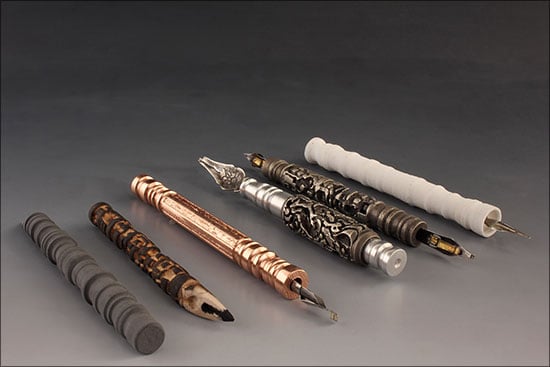Materials: Plastic, Wood, Copper, Aluminum, Sterling Silver, Alundum Stone
Dimensions: 6" x 5" x 5"
Each fountain dip pen is different and one of kind, but they are united by their utility to be used as a tool to write the written word.
Photo credit: Jonathan Inkman
Jonathan R Inkman
Milwaukee, WI. USA
I make bespoke fountain dip pens with the ability to roller print a standard mass produced image or line, and simultaneously with the ability to be an instrument for personalized self expression. My work is dialectical: I think that contradiction between standardization and personalization can be expressed at the same time. This work is my attempt at responding and bearing witness to the Technological System (modern mans environment), the ensemble of technologies that make up the the all encompassing whole. The city has the greatest concentration of technology, therefore most of my aesthetic and visual language focuses on architectural forms in a state of collapse or ruin. Technology suppresses creativity and spontaneity because it mechanizes, systematizes, and standardizes all aspects of our life. I find that the written word is a contradiction to the overly organized technological system, because it is capable of challenging standardization in the city, by laying a per sonalized mark upon a ready made world. It shows the presence of an individual’s work that goes its own way rather then becoming assimilated by technology, for the sake of efficiency, which has become a necessity.
Ganoksin hosts the jewelry list Orchid, with over 13,000 list members from all over the world, speaking from a wide range of technical and aesthetic experiences. The exhibition theme grew out of a desire to celebrate the creativity encompassed in this wide variety.
Artists were free to interpret the theme in any way they chose. Each artist could submit up to six pieces. Interpretations include uniting different materials into one cohesive form; intellectual and emotional “unitings”, where the meaning of the piece unites multiple concepts; the uniting of time - past, present and future; and a number that focus on the harmony created when uniting multiple materials and/or concepts.
The work submitted involved a wide range of jewelry techniques, from very traditional to very cutting edge, as well as using materials from traditional precious metals and gemstones to “re-purposed” and “up-cycled” materials.
The exhibition showcases 330 images chosen from entries from over 111 artists representing 26 countries.
Argentina, Australia, Belgium, Brazil, Canada, Colombia, Czech Republic, France, Greece, India, Israel, Italy, Malta, Mauritius, Mexico, Netherlands, New Zealand, Philippines, Serbia, Spain, Trinidad, Turkey, UK, USA, Venezuela, and the Virgin Islands
Many of the participants began their interest in jewelry at a young age. Some are relative newcomers to the field, and some have over 35 years of experience as professional jewelers and goldsmiths. While some grew up in families that were goldsmiths, and followed in those footsteps, others only began creating jewelry as adults.
